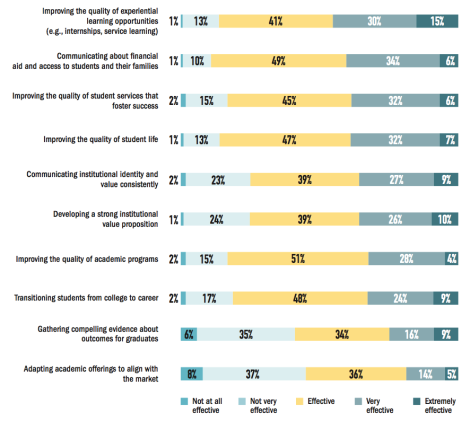Christina Fleming (@bbfleming) is the senior director of marketing & enrollment services for Blackboard Student Lifecycle Services.
A recent study from the Chronicle of Higher Education collected perspectives on the state of admissions efforts today from 400 admissions and enrollment leaders at four-year colleges and universities. Taken together, the data paints a revealing picture of the state of higher education admissions today.
How do these leaders view the effectiveness of their institutions in demonstrating value? What do they see as the most urgent issues in enrollment? Let’s dive into some of the results.
The Most Pressing Issues Facing Institutions
Enrollment officers rated their concern over issues facing their institutions on a five-point scale: “Not at all concerned,” “Not very concerned,” “Concerned,” “Very concerned” or “Extremely concerned.”
Figure 1. How Concerned Enrollment Officers Are About Pressing Issues Facing Their Institutions

The issue that garnered the most concern was the sustainability of a high-cost, high-discount pricing model for higher education (31 percent of respondents). Overall, 85 percent of institutions were “concerned,” “very concerned” or “extremely concerned” about this issue. The results indicate that as the higher education landscape changes and student demographics shift, there is an overwhelming consensus that this challenge requires close attention.
Similarly, respondents reported high rates of overall concern about the public focus on defining the value of higher education and the discussion of a student debt “bubble” in the public sphere. The prevailing mood that emerges is precariousness—a sense that the financial model underlying higher education today will not last and that the public need for institutions to demonstrate value represents a major challenge.
Between the cost of education and the common perception that a degree isn’t worth what it once was, the question can be framed as one of return on investment. Many consumers believe they will receive an insufficient return on a high investment, so they are wary. The challenge is for schools to not only deliver strong value, but also communicate it successfully to students.
How, then, do institutions view their own efforts to demonstrate value across key areas?
Demonstrating Value
Admissions officers were asked to rate the effectiveness of their institutions in proving value across a variety of areas. Again, ratings were on the five-point scale noted above.
Figure 2. How Effective Admissions Officers Believe Their Institutions Are in Proving Value

Admissions officers regard their institutions as relatively effective across most of the major areas identified in the survey. Notably, however, only 25 percent of respondents describe their efforts at measuring student outcomes as “very effective” or “extremely effective.” Moreover, this is one of the most prominent areas of self-critique with more than 40 percent of respondents describing their efforts as “not very effective” or “not at all effective.”
Given this response, it’s notable that the only category to score even more poorly, in terms of institutional effectiveness, was schools’ adaptations of academic offerings to align with the market. I’ve consistently found that enrollment results and the alignment of academic programs with the market are inextricably intertwined. When institutions do not offer programs that support students’ career goals—and labor market demands—it is reasonable to assume that enrollment will suffer as a result.
The solution is to align an institution’s programs with students’ career goals and areas of job opportunity. Improvements in student outcomes and enrollment will follow. With more effectively measured improvements in student outcomes, including job placement, institutions will be better equipped to demonstrate value to the public and more generally renew confidence in higher education. By aligning programs more closely with student and labor market demand, educational institutions can address some of the most urgent questions they face today and position themselves for a more sustainable future.

Pingback: 4 Tips for Maximizing Your Web Presence - Hanover Research·
Greetings,
I attempted to click on the link to the blog, but it appears that it isnât working. Suggestions?
Thanks,
Lauren C. Mosley
Assistant Director of Institutional Advancement
Randolph School
1005 Drake Ave Huntsville, AL 35802
(256) 799-6117
lmosley@randolphschool.net
randolphschool.net
[randolph logo]
Get in the loop! Download the new alumni mobile app:
randolphschool.net/alumni/mobileapp
[Evertrue logo]
Hi Lauren. It should open, it does here. It is a pdf. Maybe try a different browser?